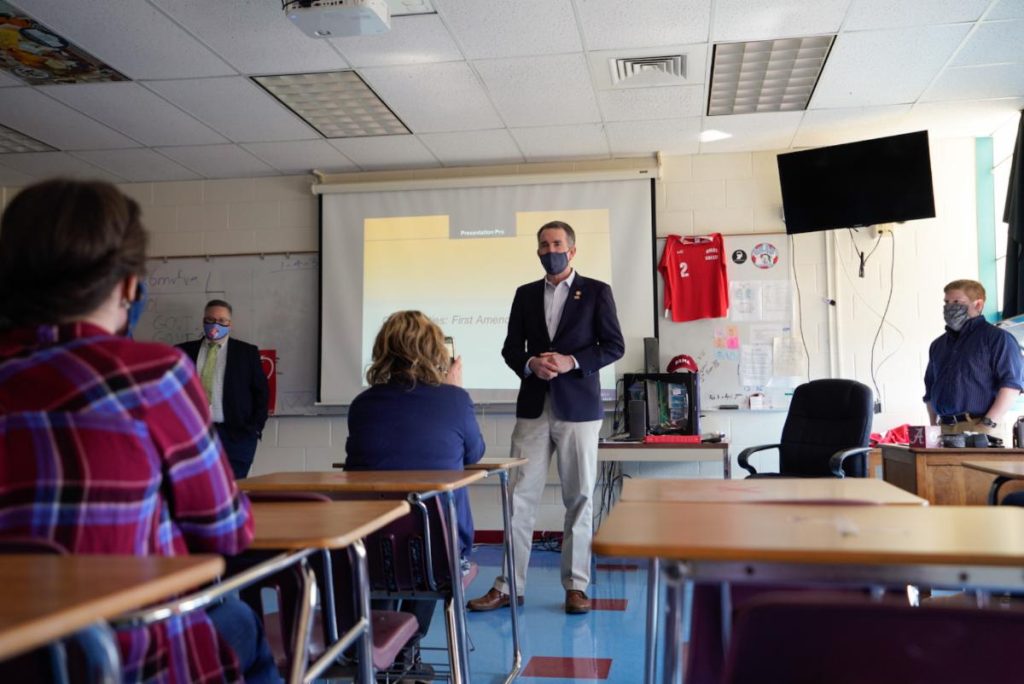 Gov. Ralph Northam on Wednesday released preliminary guidance for how K-12 schools, as well as colleges and universities, may safely hold in-person graduation and commencement events this spring. These tentative plans have been reviewed with education officials and are expected to be included in an April 1 update to Third Amended Executive Order Seventy-Two. Gov. Ralph Northam on Wednesday released preliminary guidance for how K-12 schools, as well as colleges and universities, may safely hold in-person graduation and commencement events this spring. These tentative plans have been reviewed with education officials and are expected to be included in an April 1 update to Third Amended Executive Order Seventy-Two.
Graduation events held outdoors will be capped at 5,000 people or 30 percent of the venue capacity, whichever is less. Graduation events held indoors may have up to 500 people, or 30 percent of the venue capacity, whichever is less. Attendees must wear masks and follow other guidelines and safety protocols to ensure proper distancing. Preliminary guidance for safely holding graduation and commencement events can be found here.
“I appreciate the work that our schools, students, and teachers have put in to get back into the classroom safely, and the efforts of public health officials and education leaders in developing guidelines for safe graduations and commencements this spring,” said Northam. “We are releasing this guidance early to allow schools to begin planning for this year’s events. While graduation and commencement ceremonies will still be different than they were in the past, this is a tremendous step forward for all of our schools, our graduates, and their families.”
Virginia has currently administered more than 2.7 million total COVID vaccine doses, and 1.8 million Virginians—21.3 percent of the population—have received at least one dose, while more than one million are fully vaccinated. The statewide positivity rate is 5.4 percent. About 50,000 shots are being administered to Virginians each day, and the Commonwealth is on pace to have vaccine available to everyone who wants to get vaccinated by the beginning of May. The acceleration of the vaccine program and the decrease in new COVID-19 cases make it safer to ease restrictions on activities like in-person graduations.
Virginia’s schools are also meeting Northam’s goal to expand opportunities for regular in-person instruction. In early February, Northam directed Virginia’s 132 school divisions to submit plans by mid-March for returning students to their classrooms. At that time, 25 school divisions, representing more than a third of Virginia’s students, had no plans for in-person learning. All school divisions have now submitted plans to meet that goal, and a vast majority of divisions are now offering full time classroom instruction or hybrid schedules that allow students to learn in person at least part of the week. All divisions continue to provide fully remote instructional options for students who choose to learn from home.
Over the past two weeks, Northam and state officials have visited schools at every grade level in 26 school divisions throughout the Commonwealth, highlighting innovative approaches to safe classroom instruction.
“We have met hundreds of students eager to learn and excited to be back in school with their peers and educators,” said Secretary of Education Atif Qarni. “We know that students learn best in their classrooms and will continue to work with divisions to ensure children across our Commonwealth have access to in-person learning options.”
Virginia prioritized vaccinating teachers and school staff early on, and more than two-thirds have received at least one dose of the vaccine.
“Given the rapid progress we are making with vaccinating teachers and staff, and what we now know about how schools can operate safely with proper mitigation measures, I believe in-person instruction will be the norm in every Virginia school division this fall,” said Superintendent of Public Instruction James Lane. “In fact, many of our school divisions—with guidance from the state—are already looking beyond the immediate issues related to returning students to their classrooms and are developing plans to make up the ground that has been lost over the past year.”
The American Rescue Plan Act, which was signed into law last week by President Biden, includes $122 billion to support K-12 school recovery efforts nationwide. Ninety percent of the funding will go directly to local school districts based on the formula for distributing federal Title I funds. Ten percent of the funding under the act will support state-level initiatives to help schools recover from the pandemic. According to estimates, Virginia will receive approximately $2.1 billion, with $1.9 billion going directly to school divisions, and approximately $200 million reserved to support state-level K-12 recovery initiatives.
|



 Gov. Ralph Northam on Wednesday released preliminary guidance for how K-12 schools, as well as colleges and universities, may safely hold in-person graduation and commencement events this spring. These tentative plans have been reviewed with education officials and are expected to be included in an April 1 update to Third Amended Executive Order Seventy-Two.
Gov. Ralph Northam on Wednesday released preliminary guidance for how K-12 schools, as well as colleges and universities, may safely hold in-person graduation and commencement events this spring. These tentative plans have been reviewed with education officials and are expected to be included in an April 1 update to Third Amended Executive Order Seventy-Two.